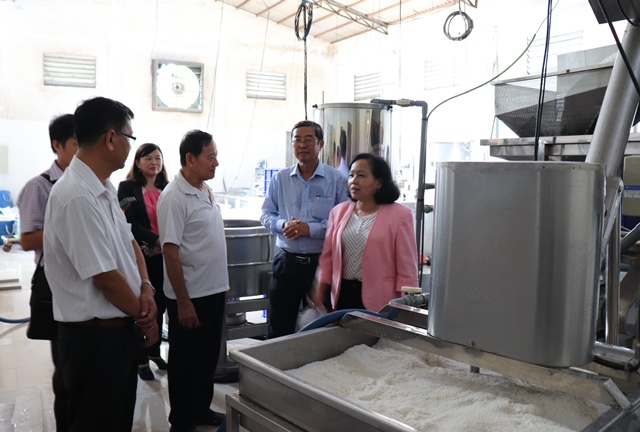 Society
Society


|
| Tư Nương Rice-Flour Production Establishment in Đồng Tháp District's Sa Đéc City. — Photo www.baodongthap.vn |
ĐỒNG THÁP — Bột or Flour village in Sa Đéc City in the Cửu Long (Mekong) Delta province of Đồng Tháp has invested in new machinery to modernise rice-flour production to sustain the Sa Đéc brand that has existed for over 100 years.
In recent years the village has faced many difficulties in production, but has managed to cope with them.
Nguyễn Kim Hương, owner of a flour production establishment in Tân Phú Đông Commune, said the business is associated with pig farming as the residues from the production process is used to feed the animals.
But with 85 per cent of the pigs raised locally dying or being culled due to African swine fever, the residues are not used and often pollute the environment since producers directly dump it into canals and ditches, she said.
Her establishment processes four to five tonnes of rice and broken rice daily to produce seven tonnes of wet flour and two tonnes of wet residues.
The price of the residue used to be around VNĐ1,000 (US$0.04) per kilogramme, but has dropped to VNĐ200-500 ($0.01-0.02) due to the swine fever.
“Luckily, this problem has been solved with the local authorities helping us buy drying machines,” Hương said.
The provincial industrial promotion and development consultancy centre has subsidised her purchase of solar residue drying machines by 50 per cent.
She has bought two of them with a daily capacity of two tonnes each.
The quality of the residues is better when dried by machines than under the sun, she said.
“Besides, the weather does not matter, we save labour costs and store the product for a long time.”
The price of dried residue is VNĐ5,000-5,500 ($0.22-0.24) per kilogramme, but often there is not enough to sell.
Nguyễn Văn Nương, 72, owner of the Tư Nương Rice Flour Production Establishment, said his family has been engaged in the business for three generations.
In the past most of the work was done manually and required a lot of time and labour, and a household could only produce 100kg of flour a day, he said.
He has invested in mechanisation and now produces 20-40 tonnes of flour a month with only four or five employees.
He has also invested in a technology to produce rice-flour drinking straws.
Võ Thanh Tùng, chairman of the Sa Đéc People’s Committee, said the Bột village now has 346 households making rice flour, mostly in the city’s Tân Phú Đông and Tân Quy Tây communes and Ward 2, and each produces 65 tonnes of flour and 42 tonnes of residues every day.
They also improved their market access, expanded production, and developed new products that meet consumers' requirements, he said.
But Bột village faces many difficulties such as lack of deep pockets, price and demand volatility and rapid urbanisation, he said.
In the first quarter of this year its flour output decreased by 30 per cent due to the pandemic, he said.
A plan to develop the Bột village by 2020 has encouraged rice-flour establishments to use advanced technologies and machinery.
Last year city authorities provided subsidies to three households in Tân Phú Đông Commune for buying five drying machines.
They will continue to provide these subsidies.
They also plan to set up the Sa Đéc Rice-Flour Making Village Co-operative to better handle issues related to finding markets and inputs, adding value to products and improving profits. — VNS